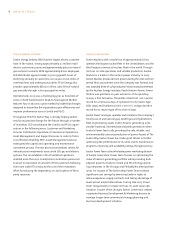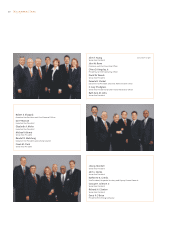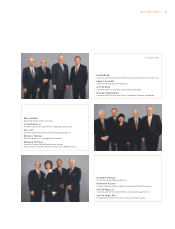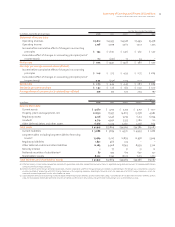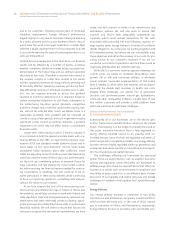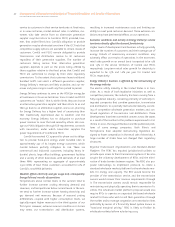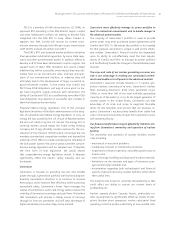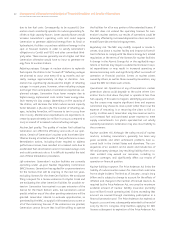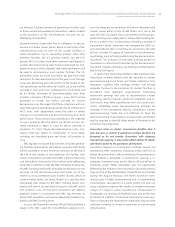ComEd 2003 Annual Report Download - page 30
Download and view the complete annual report
Please find page 30 of the 2003 ComEd annual report below. You can navigate through the pages in the report by either clicking on the pages listed below, or by using the keyword search tool below to find specific information within the annual report.
28 Management’s Discussion and Analysis of Financial Condition and Results of Operations
EXELON CORPORATION AND SUBSIDIARY COMPANIES
Effective management of capital projects is important to our
business.
Energy Delivery’s business is capital intensive and requires sig-
nificant investments in energy transmission and distribution
facilities and in other internal infrastructure projects.
We expect to continue to make significant capital ex-
penditures to improve the reliability of our transmission and
distribution systems in order to provide a high level of serv-
ice to its customers. We further expect Energy Delivery’s
capital expenditures to exceed depreciation on its plant as-
sets. Energy Delivery’s base rate freeze and caps will gen-
erally preclude incremental rate recovery on any of these
incremental investments prior to January 1, 2007.
Our business may be significantly affected by the end of the
Illinois and Pennsylvania regulatory transition periods.
Illinois electric utilities are allowed to collect competitive
transition charges (CTCs) from customers who choose an
alternative supplier of electric generation service or choose
ComEd’s power purchase option (PPO). CTCs were intended
to assist electric utilities, such as ComEd, in recovering
stranded costs that might not otherwise be recoverable in a
fully competitive market. The CTC charge represents the dif-
ference between the market value of delivered energy (the
sum of generation service at market-based prices and the
regulated price of energy delivery) and recoveries under his-
torical bundled rates, reduced by a mitigation factor. The
CTC charges are updated annually. Over time, to facilitate
the transition to a competitive market, the mitigation factor
increases, thereby reducing the CTC charge.
In 2003 and 2002, ComEd collected approximately $300
million of CTC revenue annually. As a result of increasing
mitigation factors, changes in energy prices and the ability
of certain customers to establish fixed, multi-year CTC rates
beginning in 2003, we anticipate that this revenue source
will decline to approximately $180 million to $200 million in
each of the years 2004 through 2006. Under the current re-
structuring statute, no CTCs will be collected after 2006.
Through 2006, ComEd will continue to have an obliga-
tion to offer bundled service to all customers (except certain
large customers with demand of three megawatts or more)
at frozen price levels, under which a majority of ComEd’s
residential and small commercial customers are expected to
continue to receive service. ComEd’s current bundled service
is generally provided under an all-inclusive rate that does
not separately break out charges for energy generation serv-
ice and energy delivery service, but charges a single set of
prices. After the transition ends in 2006, ComEd’s bundled
rates may be reset through a regulatory approval process,
which may include traditional or innovative pricing, includ-
ing performance-based incentives to ComEd.
In order to address post-transition uncertainty, we are
continually working with Illinois state and business
community leadership to facilitate the development of a
competitive electricity market while providing system reli-
ability. Transparent and liquid markets will help to minimize
litigation over electricity prices and provide consumers
assurance of equitable pricing. At the same time, we are at-
tempting to establish a regulatory framework for the post-
2006 timeframe and we are pursuing measures that will
provide greater productivity, quality and innovation in our
work practices across Exelon. Currently, it is difficult to pre-
dict the framework for or the outcome of a potential regu-
latory proceeding to establish rates after 2006.
In Pennsylvania, the Pennsylvania Electricity Generation
Customer Choice and Competition Act (Competition Act)
provides for the imposition and collection of non-bypassable
CTCs on customers’ bills as a mechanism for utilities to
recover their allowed stranded costs. CTCs are assessed to
and collected from virtually all retail customers who access
PECO’s transmission and distribution systems. These CTCs
are assessed regardless of whether the customer purchases
electricity from PECO or an alternative electric generation
supplier. The Competition Act provides, however, that PECO’s
right to collect CTCs is contingent on the continued oper-
ation, at reasonable availability levels, of the assets for which
the stranded costs were awarded, except where continued
operation is no longer cost efficient because of the transition
to a competitive market.
PECO has been authorized by the PUC to recover
stranded costs of $5.3 billion over a twelve-year period end-
ing December 31, 2010, with a return on the unamortized
balance of 10.75%. At December 31, 2003, approximately $4.3
billion had yet to be recovered. Recovery of transition charges
for stranded costs and PECO’s allowed return on its recovery
of stranded costs are included in revenues. Amortization of
PECO’s stranded cost recovery, which is a regulatory asset, is
included in depreciation and amortization expense. PECO’s
results will be adversely affected over the remaining tran-
sition period ending December 31, 2010 by the steadily in-
creasing amortization of stranded costs. The following table
(amounts in millions) indicates the estimated revenues and
amortization expense associated with CTC collection and
stranded cost recovery through 2010.
Year
Estimated
CTC Revenue
Estimated Stranded
Cost Amortization
2004 $ 812 $ 367
2005 808 404
2006 903 550
2007 910 619
2008 917 697
2009 924 783
2010 932 880


